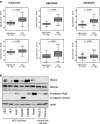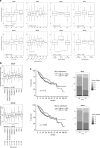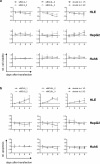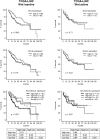Wnt status-dependent oncogenic role of BCL9 and BCL9L in hepatocellular carcinoma
- PMID: 31440992
- PMCID: PMC7220899
- DOI: 10.1007/s12072-019-09977-w
Wnt status-dependent oncogenic role of BCL9 and BCL9L in hepatocellular carcinoma
Abstract
Background: Activation of Wnt/β-catenin pathway is a frequent event in hepatocellular carcinoma and is associated with enhanced cell survival and proliferation. Therefore, targeting this signaling pathway is discussed as an attractive therapeutic approach for HCC treatment. BCL9 and BCL9L, two homologous coactivators of the β-catenin transcription factor complex, have not yet been comprehensively characterized in HCC. We aimed to elucidate the roles of BCL9 and BCL9L, especially regarding Wnt/β-catenin signaling and their prognostic value in HCC.
Methods: Expression of BCL9/BCL9L was determined in HCC cell lines (HLE, HLF, Huh7, HepG2, Hep3B, and Huh6) and normal liver cell lines (THLE-2 and THLE-3). To analyze proliferation and apoptosis, BCL9 and/or BCL9L were knocked down in Wnt-inactive HLE and Wnt-active HepG2 and Huh6 cells using siRNA. Subsequently, Wnt reporter assays were performed in HepG2 and Huh6 cells. BCL9 and BCL9L expression, clinicopathological and survival data of public HCC datasets were analyzed, taking the Wnt signaling status into account.
Results: Knockdown of BCL9L, but not of BCL9, reduced Wnt signaling activity. Knockdown of BCL9 and/or BCL9L reduced cell viability and increased apoptosis of Wnt-inactive HCC cells, but had no effect in Wnt-active cells. Expression of BCL9 and BCL9L was upregulated in human HCC and increased with progressing dedifferentiation. For BCL9L, higher expression was observed in tumors of larger size. Overexpression of BCL9 and BCL9L correlated with poor overall survival, especially in HCC without activated Wnt signaling.
Conclusion: Oncogenic BCL9 proteins represent promising targets for cancer therapy and inhibiting them may be particularly beneficial in Wnt-inactive HCCs.
Keywords: B9L; BCL9-2; Liver cancer.
Conflict of interest statement
The authors declare that they have no conflict of interest.
Figures





Similar articles
-
The interactions of Bcl9/Bcl9L with β-catenin and Pygopus promote breast cancer growth, invasion, and metastasis.Oncogene. 2021 Oct;40(43):6195-6209. doi: 10.1038/s41388-021-02016-9. Epub 2021 Sep 20. Oncogene. 2021. PMID: 34545187 Free PMC article.
-
Hypoxia activates Wnt/β-catenin signaling by regulating the expression of BCL9 in human hepatocellular carcinoma.Sci Rep. 2017 Jan 11;7:40446. doi: 10.1038/srep40446. Sci Rep. 2017. PMID: 28074862 Free PMC article.
-
A cytoplasmic role of Wnt/β-catenin transcriptional cofactors Bcl9, Bcl9l, and Pygopus in tooth enamel formation.Sci Signal. 2017 Feb 7;10(465):eaah4598. doi: 10.1126/scisignal.aah4598. Sci Signal. 2017. PMID: 28174279
-
Integrative analysis of aberrant Wnt signaling in hepatitis B virus-related hepatocellular carcinoma.World J Gastroenterol. 2015 May 28;21(20):6317-28. doi: 10.3748/wjg.v21.i20.6317. World J Gastroenterol. 2015. PMID: 26034368 Free PMC article. Review.
-
Recent advances in β-catenin/BCL9 protein-protein interaction inhibitors.Future Med Chem. 2021 May;13(10):927-940. doi: 10.4155/fmc-2020-0357. Epub 2021 Apr 14. Future Med Chem. 2021. PMID: 33849283 Review.
Cited by
-
BCL9/BCL9L in hepatocellular carcinoma: will it or Wnt it be the next therapeutic target?Hepatol Int. 2020 Jul;14(4):460-462. doi: 10.1007/s12072-020-10059-5. Epub 2020 Jun 1. Hepatol Int. 2020. PMID: 32488834 Free PMC article. No abstract available.
-
Discovery of an Orally Bioavailable Small-Molecule Inhibitor for the β-Catenin/B-Cell Lymphoma 9 Protein-Protein Interaction.J Med Chem. 2021 Aug 26;64(16):12109-12131. doi: 10.1021/acs.jmedchem.1c00742. Epub 2021 Aug 12. J Med Chem. 2021. PMID: 34382808 Free PMC article.
-
Targeting Oncogenic WNT Signalling with WNT Signalling-Derived Peptides.Handb Exp Pharmacol. 2021;269:279-303. doi: 10.1007/164_2021_528. Handb Exp Pharmacol. 2021. PMID: 34455485
-
Targeting BCL9/BCL9L enhances antigen presentation by promoting conventional type 1 dendritic cell (cDC1) activation and tumor infiltration.Signal Transduct Target Ther. 2024 May 29;9(1):139. doi: 10.1038/s41392-024-01838-9. Signal Transduct Target Ther. 2024. PMID: 38811552 Free PMC article.
-
Identification of ceRNA (lncRNA-miRNA-mRNA) Regulatory Network in Myocardial Fibrosis After Acute Myocardial Infarction.Int J Gen Med. 2021 Dec 19;14:9977-9990. doi: 10.2147/IJGM.S329391. eCollection 2021. Int J Gen Med. 2021. PMID: 34984022 Free PMC article.
References
-
- Stewart BW, Wild CP. World Cancer Report 2014. Lyon: International Agency for Research on Cancer/World Health Organization. 2014
MeSH terms
Substances
Grants and funding
LinkOut - more resources
Full Text Sources
Medical
Miscellaneous

